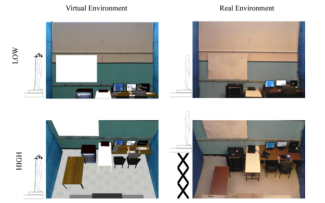
The cluster is pleased to announce a new exciting partnership with the virtual reality (VR) solutions company WorldViz. Founded 2002 in Santa Barbara, CA, WorldViz is an industry-leading provider of VR solutions for the academic, public, and enterprise sectors. Its patented VR solutions are deployed across 1500+ academic institutions, government agencies, and Fortune 500 companies.
In research and development, WorldViz VR solutions enable ground-breaking experimental setups that would be impossible in the real world while guaranteeing high experimental control and ecological validity. The WorldViz Vizard VR software, the Matlab of VR, has long been the chosen engine for R&D in both university and business settings. Specifically, WorldViz solutions allow users involved in research the opportunity to: 1) create a cost-effective experiment where reality can be simulated to capture accurate results; 2) set up controlled and repeatable experiments; 3) manipulate the world in ways normally impossible or prohibitively expensive in reality, and; 4) automate analysis of physiological data.
WorldViz VR equipment has allowed cluster researchers to conduct experiements with particpipants which would not ordinarily be possible due to safelty and feasibility issues. For example, the use of virtual height which has been tested and shown to elicit emotional and postural changes similar to those experiences in real settings (Cleworth et al., 2012: See figure 1), can be used to test the effect of fear on balance control.

Figure 1: Experimental setup for virtual and real environments as used by Cleworth et al., (2012) comparing the visual scene (observed by the participant) in the low and high conditions. The model located to the left of each visual scene illustrates the actual standing orientation of the participant during each condition.
Vizard, allows researchers to build precise and complex simulations that connect to VR headsets, CAVEs and Powerwalls, head/hand motion trackers and motion capture systems, and specialty devices such as eye trackers, haptic feedback devices, and biophysical sensors such as EEGs, EKGs and GSRs. Data collection, analysis, and full experimental control are possible through Vizard’s Python-based coding interface and layout of modules for scientific research.
As part of this partnership, WorldViz is offering all cluster members a “one-time in-kind discount” for Vizard VR software purchases. To allow members to replicate/expand on existing research from Professor Mark Carpenter at University of British Columbia, WorldViz offers to sell Vizard Enterprise Edition licenses for the price of the Vizard Development Edition.
Cluster members should contact WorldViz at sales@worldviz.com and request a Vizard quote for “Origins of Balance Deficits and Falls Research Cluster” or ask to set up a phone call to consult with the sales team on a solution which best fits what they are aiming to achieve in their research.
If any cluster members have any queries regarding this generous offer from WorldViz, please don’t hesitate to contact us here.

Figure 2: Cluster members Mark Carpenter and Taylor Cleworth using virtual reality to examine the role of fear in balance control in the UBC Kinesiology Neural Control of Posture and Movement Lab.